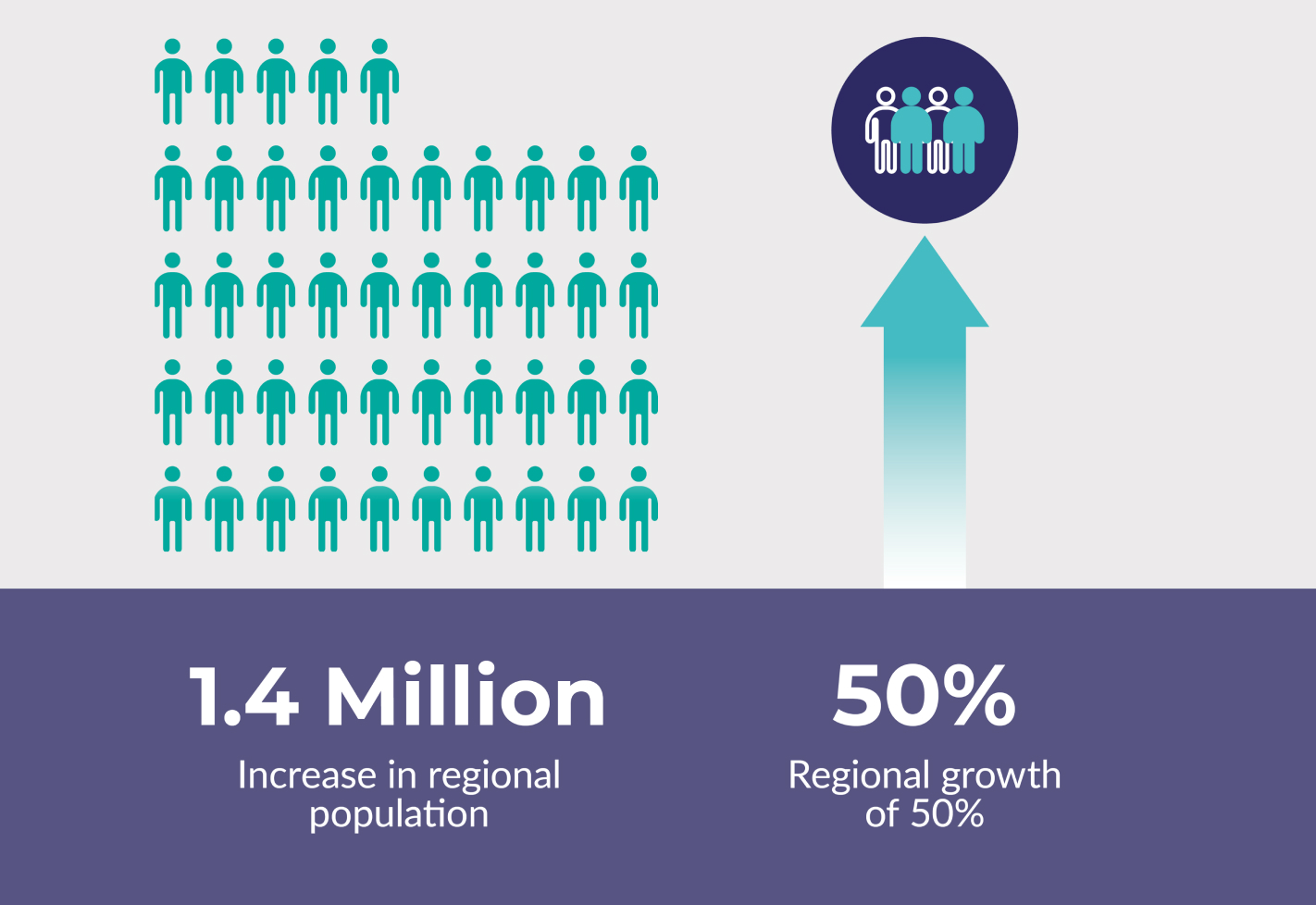Expand Mobility Choices
Our region is projected to experience exponential population growth over the next twenty years, and as a result, there will be a need for increased mobility. This Mobility Move focuses on how our regional partners can work together to expand transportation demand management (TDM) strategies, enhance the experience of using our region's total mobility network services, embrace emerging mobility trends, and implement a network of Mobility Hubs to support our region's total mobility network.
Transportation Demand Management
Did you know?
It is projected that by 2045, the region’s population will increase by about 1.4 million people, a growth of over 50 percent. By that time, approximately 4.1 million people total will live in the 12-county CONNECT Beyond region.

TDM is a set of strategies that seek to change how and when people travel. The goal of TDM is to reduce the number of people driving private vehicles in general but particularly during peak travel hours. TDM strategies encourage people to use alternative mobility options, travel during off-peak hours, or reduce their overall transportation demand by teleworking. TDM strategies are either focused on increasing mobility options or changing travel behaviors.
Examples of Transportation Demand Management Strategies
-
Enhanced bicycle and pedestrian options
-
Promoting rideshare services
-
Encouraging carpooling programs
-
Increasing access to public transit services
Increasing Mobility Options
- Flextime work schedules
- Limited parking
- Employer discount passes for public transit
- Public information campaigns encouraging public transit use
Changing Travel Behaviors
Benefits of Transportation Demand Management
- Flexible Work Schedules
- Telework
- Walk
- Bike
- Transit
- Vanpool/Carpool
- Rideshare
Travel Options
- Mobility Incentives
- Events + Challenges
- Apps + Technology
- Employer Programs
- Safe Routes to Schools
- Education + Encouragement Programs
- Parking Pricing + Management
Change Tools
- Reduce Driving + Parking Demand
- Reduce Travel Times
- Cost Savings for Workers + Businesses
- Increased Walking, Biking, and Transit
- Economic Development
- Increased Roadway Capacity for Freight Mobility
Desired Outcomes
What Are Mobility Hubs?
Mobility hubs are connection points where users can access different types of mobility services and make seamless transfers between services that may be operated by different transit providers.
There are no one-size-fits all design for a mobility hub, but instead, they are scaled to reflect the unique context and needs of a particular area.
CONNECT Beyond identified 74 locations throughout the region where mobility hubs can be implemented and serve as important connection points for the region's recommended strategic mobility corridors.
To learn more, refer to Section 4 in the CONNECT Beyond Regional Mobility Plan.
Read the Final PlanHow We'll Get There: Mobility Choice Recommendations
Develop a Regional Transportation Demand Management (TDM) Plan
Timeframe: ImmediateThis Regional TDM Plan should aim to provide information, incentives, and resources to encourage our region's residents and visitors to make the best possible use of the alternative mobility options available in our region.
Develop a Commuter Choice Program
Timeframe: ImmediateCONNECT Beyond recommends the Centralina Regional Council and CATS work together to develop and lead a Commuter Choice Program that would implement a variety of different TDM strategies and would serve residents in the CONNECT Beyond region.
Create an All-In-One Digital Platform for the Region's Total Mobility Network
Timeframe: Near-TermCreate an all-in-one website and phone application (available for iPhones and Androids) that residents and visitors can use to plan and pay for their trips and learn about the variety of alternative commuting options and programs available in our region.
Single Payment System for the Total Mobility Network
Timeframe: Near-TermCONNECT Beyond recommends our regional partners develop a Fare Policy Working Group to lead a Mobility Services Fare Review Study. This Mobility Services Fare Review Study will explore ways to implement an integrated regional fare system for all mobility services in our region and will explore potential fare payment technologies that could help make it easier for the user to pay for multimodal trips in a single fare payment platform.
Establish an Emerging Mobility Working Group
Timeframe: ImmediateThe Emerging Mobility Working Group will pilot and implement first-mile/last-mile solutions, ride-share coordination, electric vehicle technologies, innovations for seniors/persons with disabilities, and other relevant mobility recommendations presented by CONNECT Beyond.
Move Towards an Integrated Electric Fleet and Charging Network
Timeframe: ImmediateWork with transit providers on an electric fleet inventory and survey the CONNECT Beyond region's transit providers on electric fleet conversion goals and timelines. The CONNECT Beyond Emerging Mobility Working Group should perform an Electric Fleet Suitability Analysis of where individual or shared agency electric infrastructure would be optimally located in particular charging stations.
Complete a Region-Wide Emerging Mobility Suitability Assessment
Timeframe: Near-TermThis region-wide Emerging Mobility Suitability Assessment will help clarify where and how public resources should be applied to capture benefits from emerging mobility.
Fund and Initiate a Regional Mobility Hub Implementation Strategy
Timeframe: Near-TermIn the long-term, the integration of mobility hubs is needed to better connect transit providers and alternative mobility services around the region.
Develop a Mobility Hub Pilot Program
Timeframe: Mid-TermDevelop a Mobility Hub Pilot Program that implements a limited number of demonstration sites with low-cost temporary installations and evaluate outcomes.
Integrate the CONNECT Beyond Mobility Hub Locations into Local, County, and Regional Transit Plans
Timeframe: Mid-TermThis will allow for more effective connections and customer transfers between various transit services, including transfers between different fixed-route urban transit services, transfers between different community transportation provider services, and transfers between fixed-route urban transit services and community transportation provider services.







